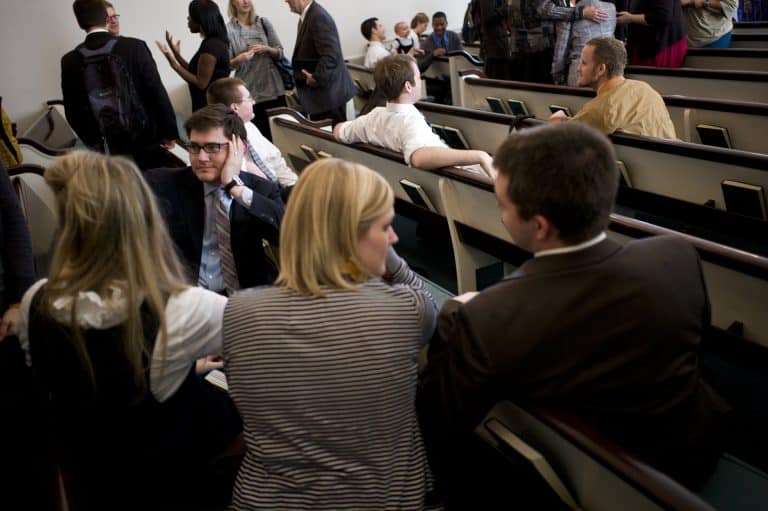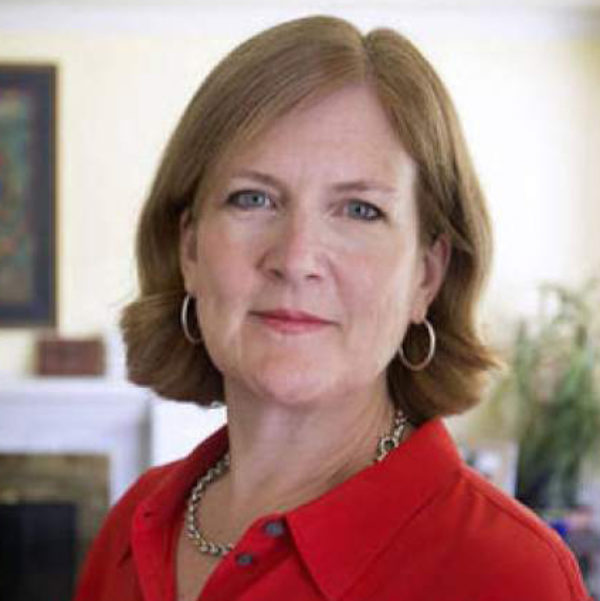
Image by Brendan Smialowski/Getty Images, © All Rights Reserved.
The Challenge of Not Choosing Sides
On the first Sunday in May, at a Mormon church in Utah, a 12-year-old girl came out to her congregation as a lesbian. What must have been one of the most meaningful events in young Savannah’s life was, with her permission, captured in a video by a friend who had come to lend support. This video not only documents the bravery of a queer girl in a conservative faith community, but the inevitable pushback by that community. Two-and-a-half minutes into her testimony, the ecclesiastical leader directing the meeting turned off the microphone and asked her to sit down. Savannah, apparently, had been silenced.
Not for long.
The video went viral and predictable outrage ensued. First progressive Mormons — myself included — then the LGBTQ world at large were appalled, and understandably so. The video seems to tell it all: Powerful white males in suits and ties shut down the voice of a little girl who is speaking from the heart. News organizations from all over jumped on the story. Savannah, to her credit, managed amidst the media feeding frenzy to be an articulate advocate for herself and other LGBTQ people. She described how she felt as she returned to her seat at church that day:
“I started crying because I wanted to finish my message…but I felt happy that people could hear [some] of it…and that I was being there for someone that probably needed it.”
But despite the sincerity of Savannah’s gesture, as the video was tweeted and posted and Instagrammed over and over, I reevaluated my attitude toward the man who cut the mic. I was troubled by how this story was playing out. The complexity that the events in this testimony meeting represented were getting lost. People were lining up on one side or another. Conservative Mormons were suspect of Savannah’s motives. They were sure her ex-Mormon mother had put her up to it, and grateful to the leaders for taking a stand.
Progressive Mormons felt betrayed, wondering why the innocent words of a 12-year-old girl could threaten grown men. Outside the church, more and more well-meaning LGBTQ advocates seemed to jump onto the Savannah train in order to prove their devotion to the cause.
I am a lifelong Mormon. My ancestors were pioneers who made the iconic trek across the plains to escape persecution. My Church has been a deeply nourishing source of spirit and inspiration for me, often an opportunity to do the hard work of serving in a Christian community where my attitudes and perspectives are very different from my fellow congregants. For a long time I was resigned to there being no place for gay members; their story didn’t fit into the LDS heteronormative model of family on earth and in heaven. I saw friends leave. I wished them well. I heard of parents shunning their gay children, of suicides. I turned away.
Then, gradually, I started to question this divide. Did gay and trans people have to leave? How could I use the spiritual principles I had been practicing all these years to make the church a safe and welcoming place for all my brothers and sisters?

I was not alone in this impulse. In the last six years we have seen subtle but substantive changes in attitudes from members and leadership alike. To the outside world, Mormons may still seem stuck in the 1950s but the fact that it even occurred to Savannah to stand and declare her orientation in a church meeting speaks to a new willingness that Latter-day Saints have to grapple with issues of faith and identity.
But change in attitude does not mean change in doctrine. The LDS Church still considers homosexual relationships sinful. Heterosexual marriage is the only way into Mormon heaven. Our male lay clergy (and, yeah, that’s a whole other story) are called to enforce the definition of same-sex bonds as “apostate.” When they accept a position in local leadership, this is one of the tenets they are agreeing to uphold.
As LGBTQ advocates from all quarters proclaimed Savannah a rainbow hero, I found myself dropping some of my righteous indignation and seeking compassion for the men in charge of that meeting. What were they experiencing when Savannah talked of her conviction that God does not want her to be alone and her hopes someday of marriage to a woman? How were they supposed to toe the line of orthodoxy and stand as witnesses of Christ’s unconditional love?
This is the essential question that Latter-day Saints face in issues of sexual orientation and gender identity. For some Mormons the answer is clear — health and wholeness require them to leave the Church. I honor this path. But for others like myself, living in the tension of orthodoxy and inclusion is rich with meaning.
It demands empathy and patience, attention to inner wisdom. It asks you not to take sides in internet battles, not to shame and dehumanize an entire cohort of humanity in order to show support for your own idea of what someone or something represents.
In a Mormon testimony meeting you will see members rise when moved by the Spirit, and speak of what they know to be true. Often it’s a rote catechism: Joseph Smith was a prophet, the Book of Mormon is God’s word. It’s not unusual to hear personal stories of what Jesus’ atonement means in someone’s life. And there’s always the chance of a memorable but incomprehensible narrative that in the telling helps the speaker feel less alone.

There’s a truth I can testify to out there that’s even bigger than a 12-year-old’s courage or a clergyman’s duty to his beloved church. That truth lies in the answer to this question: Both Savannah and her leaders are inherently worthy of love and belonging in our community, so how do we make that love, that belonging, a reality? And since the answer is so far from our grasp at the moment, what does just “living in the question,” as Rilke puts it, look like?
My hunch is that it has something to do with the spirit we bring to the week-to-week activities of a congregation: the scripture study, the Sunday worship, the service projects, the church suppers. Can I let the gay and trans kids know I am their ally? Can I listen to their parents? Likewise, can I forge relationships of understanding and respect with my ecclesiastical leaders: my bishop, Steve, who loves his motorcycle; his counselor, Rob, who is raising his blended family of eight with joy? Can I look beyond their suits and ties, their power to silence, and see them as individuals who struggle just like I do?
If I’m going to continue my journey in the conservative faith community I was born into, the answer has to be yes. And until humanity finds a way to wrestle the internet into submission, when the next faith controversy hits social media (tomorrow? the next day?) I’ll resist the temptation to weaponize it.

Share your reflection